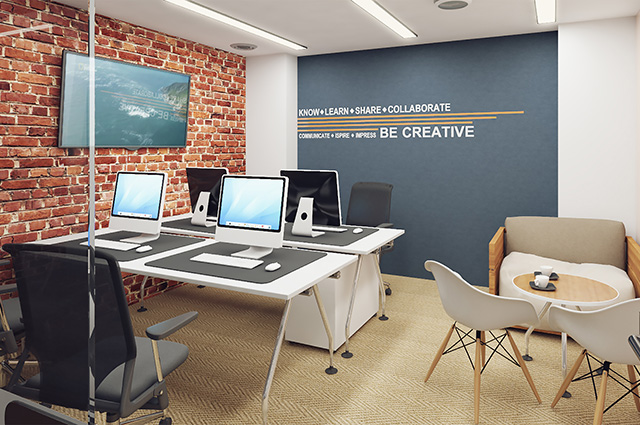Both large and small businesses can benefit from the hot desking arrangement. Team members don’t have their own desks, so they sit at whatever is free. This could be done on a first-come, first-served basis, or through a hot desk reservation system.
Coworking spaces, or “hot desks,” can be a great addition to a dynamic workplace. They can supplement the conventional workplace by allowing workers to choose their own working environment and by making full-time and other positions available to part-time and hybrid workers.
There are advantages to becoming hot-desk only for some businesses. It’s important to consider your team’s needs before deciding to provide them with hot desks.
In this article, we’ll discuss the benefits and drawbacks of hot desking, as well as how to figure out if it’s a good fit for your company.

Hot desking’s benefits
Some workplaces are well-suited to “hot desk” arrangements, whereas others are not. Think about how hot desking might help you and your company when you plan your office layout.
Improved office space utilisation
When an employee is on vacation, sick leave, or otherwise not in the office, the person’s assigned desk can collect dust. It’s an unnecessary waste of workplace resources.
With a hot desk setup, you may get by with fewer permanent desks and a more compact workplace. As a result, businesses can save money by renting only the area they need.
Increasing group and team adaptability
Workers are more likely to create impromptu groups to work on projects thanks to hot desking. One example of this adaptability is the ability to temporarily reserve a pair of adjacent workstations for collaborative initiatives without disrupting the flow of the office.
Draws in top-tier individuals
Creative people are more likely to join a less rigorous organisation. After all, hot desking encourages a better work-life balance by letting workers choose their own workspace.
Cleaner work areas
People are less likely to leave their personal items or work-related equipment laying around a “hot desk,” hence the environment is usually neater and more organised. To encourage hygiene, several hot desk spaces have rules requiring patrons to return their seats to their original configuration after using them.
Hot desking’s drawbacks
It’s important to keep in mind that hot desking isn’t without its consequences. Some of these disadvantages help to explain why some businesses are wary about implementing hot desking policies.
There is less team unity.
For certain groups, being united is more productive than being split up or constantly interrupted.
Teams that collaborate frequently (such as those in sales and marketing) benefit from remaining in close proximity to one another.
Managers and leaders in hot desking environments must also rethink traditional methods of team engagement and communication.
Doesn’t have any customization options
Employees who keep frequently used goods in their desk drawers may find this inconvenient. Desks are also more difficult to customise with things like photos of family and seasonal decorations.
It can be hard to tell where you are in the hierarchy.
Perhaps having a clear chain of command might help. That might be done so workers know who to contact for assistance on the job.
It may be standard practise at some firms for managers and team leaders to keep an eye on employees at all times in order to ensure they are staying focused and productive. Not every business functions well in a casual work setting, such as one where employees share desks.
To a large extent, these drawbacks can be mitigated by employing a hybrid system. Here, conventional open-plan and private offices exist side by side with coworking and remote spaces.

Assessing the Fit of Hot Desking for Your Organisation
Make sure that shared office space is suitable for your company before committing to hot desks. All of the benefits and drawbacks have been listed above.
However, you need weigh the advantages against the costs to see if they are truly worthwhile. While there is no such thing as a perfect system, you may be able to reap long-term benefits for your company if the advantages outweigh the disadvantages.
Take into account the work environment and company culture
Many people prefer the laid-back atmosphere of a hot desk over that of a traditional office. One reason is that it seems less out of reach.
This is useful if your company has a nontraditional organisational structure, such as ‘pods’ or a flatter management structure.
Sales and research and development (R&D) teams, for instance, frequently work together towards same goals.
Second, evaluate the current office layout and technology setup. The underutilization of resources is a persuasive incentive to select coworking spaces.
A full-time worker is eligible for four to six weeks of annual leave every year. A desk may only be used half of the time due to things like illness, working from home, utilising coworking spaces, and client visits.
If you have a staff of 30, that adds up to a lot of wasted square footage that you’re paying for.
For the past decade or so, businesses have been slowly shifting towards more adaptable workplaces. It’s become the standard for businesses to combine remote and in-office labour.
Team members may choose to work in a variety of settings, including traditional offices, homes, and shared work areas. The advantages of working in an office setting can be enjoyed through the implementation of hot desks, while mobility and financial savings are maintained.
Assess the individual needs and working styles of your staff
It’s crucial to find out what kind of organisational structure best suits your team’s needs. As an example, creative sectors tend to be more flexible in terms of team structure, thus offering a configuration that is appealing to what is normal in your industry might be beneficial for your firm as a whole.
Think about events like meetings. If your team prefers daily briefings or more casual get-togethers, hot desking might not be the best fit.
Teams who stay in touch frequently and hold regular meetings may benefit from having their own set of desks. On the other side, a mobile staff would benefit from hot desking.
Simply inquire as to the working styles of your employees and their interest in hot desking. After all, when both management and staff are on board, workplace arrangements like this tend to flourish.

